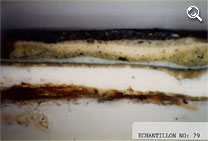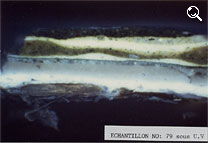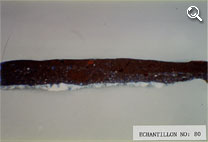| |
Analysis
of the pigments
The analysis of the pigments was done by l’Institut
D’art, Conservation et Couleur of Paris from two samples, one
of the blue-green background (sample
No: 79) and the other one from the blue area of the coat (sample
No: 80).
The identification of the pigments, binding agents and other
materials was achieved by using physical, microscopic and micro chemical
methods.
The examination of the microstructure of the painting was
done using stratigraphic sections (normal micrography, under ultraviolet).
The result of this is:
- The support is made of cardboard.
- The analysed samples contain only pigments or materials
used before 1903.
- The samples made of numerous layers reveal that the painting
has a complex stratigraphy.
- The preparatory white layer is constituted of white
lead, zinc lead containing a load of barium sulphate. The largest quantity
of white lead in the lowest layer can be explained by its higher siccative
power: which reveals a good technical knowledge of the materials by
the artist. That is no wonder since Picasso had from very young a remarkable
technique. He was a professional from the start.
- The thick preparatory layer of a white lead base
is one of the characteristics of Picasso’s technique during the
blue period in Barcelona.
- The oil based binding agent mixed with resin is
also a characteristic of Picasso’s technique at that time. The
same is true for the pigments used by Picasso who only used high quality
pigments.
- Concerning the face and neck, Picasso covered
them with mat white modulated of blues over which rosy ochres have been
quickly brushed while still wet.
- On the pictorial material of Woman in Blue
with a Beret, cracks identical to those of Celestina before
its cleaning are visible. These cracks, which are the result of the
drying and the aging of the paintings, are linked to the preparation
of the base and the pictorial material used (binding agents, pigments).
This similarity between these two paintings indicates that they were
painted with the same pigments during the same period.
|
|


Sample 79


Sample 79 under U.V.


Sample 80
 |
|
|
|

